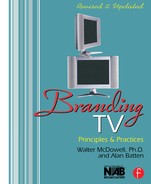First, You Need A Plan |
It is impossible to know where you are going unless you know where you are. The best way to discover where you are is to research, research, and research. Specific research techniques are discussed extensively in Chapter 10, “Measuring TV Brand Equity.”
A management team committed to moving its station forward will first make an exhaustive review of the following:
![]() The product
The product
![]() The audience available for that product
The audience available for that product
![]() The sales potential for that product
The sales potential for that product
A time-tested way of reviewing your plan is the SWOT method:
S = strengths
W = weaknesses
O = opportunities
T = threats
12.1 REVIEW THE PRODUCT
What is the product your station is providing? Is it news, entertainment, information, infomercials? Does it measure up to generally accepted standards? Is the technical end of it clean, crisp, and attractive, or is your signal fuzzy or hampered by geographic obstacles? Is your news coverage effective? Does it cover all the population centers in the station’s designated market area (DMA) or metropolitan statistical area (MSA)?
When the results of this review are in, you should have a clear-cut list of your station’s strengths and weaknesses.
![]() Do any of your strengths play off your competition’s weaknesses?
Do any of your strengths play off your competition’s weaknesses?
![]() Do you have some weaknesses that are being claimed by your competition?
Do you have some weaknesses that are being claimed by your competition?
In both cases, you may have some opportunities to increase your strengths and diminish your weaknesses. Take a look at the following questions to lay the foundation for objectives:
![]() What are the major threats to doing this aspect of branding?
What are the major threats to doing this aspect of branding?
![]() How can you make any of these threats an opportunity?
How can you make any of these threats an opportunity?
![]() How are you perceived in the community as a brand?
How are you perceived in the community as a brand?
![]() Are there “voids” in the market: areas in which neither you nor your competition is doing an effective job?
Are there “voids” in the market: areas in which neither you nor your competition is doing an effective job?
Answers to these questions form the basis of who you are as a station. And who you are as a station is your brand.
12.2 MAKE A LIST OF THE PRODUCT’S STRENGTHS AND WEAKNESSES
What threatens your objective of building on strengths and eliminating weaknesses? What potential opportunities exist or can be caused to exist? The wider you can cast your research net, the more likely your information will be close to reality. It does you no good if you just ask the management team. Go into the communities you serve and conduct anonymous research so your audience will not prejudice their answers either for or against you.
Every dollar spent on research early in the process will pay off 10-fold when the process is completed.
When the research and the management team has agreed about the station’s strengths and weaknesses, more questions have to be asked. The answers to these questions will form the basis for your branding plan.
12.3 WHAT AUDIENCE IS AVAILABLE?
It is a fact of life in the 21st century that an information explosion is saturating the public’s awareness. This is why it is vital to research the available audience and ask them what appeals to them. What would they change their current habits to look at? (If, for example, the available audience is predominantly over age 50, a younger-skewing product will most likely do a poor job in attracting or retaining viewers.)
Information on the life styles and habits of your audience may be gathered in your research and expanded upon in the focus groups. Knowing the demographic pod sizes in your audience will be invaluable when you place your media buys.
If you look up “Know Thyself” on a search engine, you will receive about 132,000 hits. But that venerable and much-used phrase is an excellent way to view your research. With the research questions answered, it’s time to set the branding process in motion.
